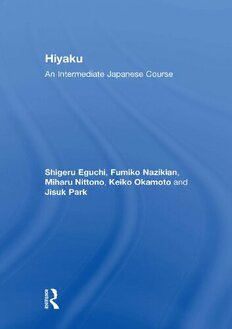
Hiyaku: An Intermediate Japanese Course PDF
Preview Hiyaku: An Intermediate Japanese Course
Hiyaku: An Intermediate Japanese Course provides a progressive intermediate course in Japanese, incorporating modern teaching methods and practicing all four language skills. Hiyaku provides content-based instruction, with authentic and semi-authentic dialogues and readings, all carefully selected to instruct and inspire students as they learn Japanese. Key features of the textbook include: • highly structured chapters, beginning with warm-up exercises followed by focused practice of each of the four skills • gradual introduction to increasingly authentic materials • content taken from original Japanese sources such as movies, books, television, magazines and newspapers • extensive audio material provided as FREE MP3 (cid:191)les on a companion website • instructor’s materials, including PowerPoint presentations provided through the com- panion site. Hiyaku does not simply teach language and basic cultural points: it also helps students to gain a holistic understanding of Japanese society and history, and provides the necessary foundation for the advanced study of Japan and its language. Shigeru Eguchi is the Administrative Director of the Summer MA Program in Japanese Pedagogy at Columbia University. Fumiko Nazikian is the Director of the Japanese Language Program at Columbia University. Miharu Nittono is a senior instructor of Japanese at Columbia University. Keiko Okamoto has taught Japanese at Columbia University since 2002. Jisuk Park has taught Japanese at Columbia University since 2002. (cid:28)(cid:26)(cid:27)(cid:19)(cid:23)(cid:20)(cid:24)(cid:26)(cid:26)(cid:26)(cid:23)(cid:26)(cid:25)(cid:66)(cid:20)(cid:66)(cid:83)(cid:85)(cid:72)(cid:17)(cid:76)(cid:81)(cid:71)(cid:71)(cid:3)(cid:3)(cid:3)(cid:76) (cid:25)(cid:18)(cid:27)(cid:18)(cid:21)(cid:19)(cid:20)(cid:20)(cid:3)(cid:3)(cid:3)(cid:20)(cid:29)(cid:24)(cid:21)(cid:29)(cid:22)(cid:20)(cid:3)(cid:51)(cid:48) This page intentionally left blank ひやく 『飛躍』 Hiyaku: An Intermediate Japanese Course Shigeru Eguchi, Fumiko Nazikian, Miharu Nittono, Keiko Okamoto and Jisuk Park (cid:28)(cid:26)(cid:27)(cid:19)(cid:23)(cid:20)(cid:24)(cid:26)(cid:26)(cid:26)(cid:23)(cid:26)(cid:25)(cid:66)(cid:20)(cid:66)(cid:83)(cid:85)(cid:72)(cid:17)(cid:76)(cid:81)(cid:71)(cid:71)(cid:3)(cid:3)(cid:3)(cid:76)(cid:76)(cid:76) (cid:25)(cid:18)(cid:27)(cid:18)(cid:21)(cid:19)(cid:20)(cid:20)(cid:3)(cid:3)(cid:3)(cid:20)(cid:29)(cid:24)(cid:21)(cid:29)(cid:22)(cid:20)(cid:3)(cid:51)(cid:48) First edition published 2011 by Routledge 2 Park Square, Milton Park, Abingdon, OX14 4RN Simultaneously published in the USA and Canada by Routledge 711 Third Avenue, New York, NY 10016 Routledge is an imprint of the Taylor & Francis Group, an informa business © 2011 Shigeru Eguchi, Fumiko Nazikian, Miharu Nittono, Keiko Okamoto and Jisuk Park Typeset in Times New Roman & Kozuka Mincho Pro by Graphicraft Limited, Hong Kong Printed and bound in Great Britain by TJ International Ltd, Padstow, Cornwall All rights reserved. No part of this book may be reprinted or reproduced or utilised in any form or by any electronic, mechanical, or other means, now known or hereafter invented, including photocopying and recording, or in any information storage or retrieval system, without permission in writing from the publishers. The right of Authors to be identi(cid:191)ed as author of this work has been asserted by him/her in accordance with sections 77 and 78 of the Copyright, Designs and Patents Act 1988. British Library Cataloguing in Publication Data A catalogue record for this book is available from the British Library Library of Congress Cataloging in Publication Data A catalog record for this book has been requested ISBN 13: 978-0-415-77747-6 (hbk) ISBN 13: 978-0-415-60897-8 (pbk) (cid:28)(cid:26)(cid:27)(cid:19)(cid:23)(cid:20)(cid:24)(cid:26)(cid:26)(cid:26)(cid:23)(cid:26)(cid:25)(cid:66)(cid:20)(cid:66)(cid:83)(cid:85)(cid:72)(cid:17)(cid:76)(cid:81)(cid:71)(cid:71)(cid:3)(cid:3)(cid:3)(cid:76)(cid:89) (cid:25)(cid:18)(cid:27)(cid:18)(cid:21)(cid:19)(cid:20)(cid:20)(cid:3)(cid:3)(cid:3)(cid:20)(cid:29)(cid:24)(cid:21)(cid:29)(cid:22)(cid:21)(cid:3)(cid:51)(cid:48) 目次 Acknowledgements ...............................................................................................................vi To the student .......................................................................................................................vii 本書について/About the book ..........................................................................................viii 復習........................................................................................................................................1 第一課 行事......................................................................................................................13 第二課 敬語......................................................................................................................39 第三課 気候......................................................................................................................65 第四課 昔話......................................................................................................................95 第五課 言葉と文化........................................................................................................125 第六課 詩........................................................................................................................151 第七課 食文化................................................................................................................179 第八課 歴史....................................................................................................................205 漢字リスト........................................................................................................................229 漢字練習シート................................................................................................................230 語彙索引............................................................................................................................255 文法項目リスト................................................................................................................260 あとがき............................................................................................................................262 参考文献............................................................................................................................264 v (cid:28)(cid:26)(cid:27)(cid:19)(cid:23)(cid:20)(cid:24)(cid:26)(cid:26)(cid:26)(cid:23)(cid:26)(cid:25)(cid:66)(cid:20)(cid:66)(cid:83)(cid:85)(cid:72)(cid:17)(cid:76)(cid:81)(cid:71)(cid:71)(cid:3)(cid:3)(cid:3)(cid:89) (cid:25)(cid:18)(cid:27)(cid:18)(cid:21)(cid:19)(cid:20)(cid:20)(cid:3)(cid:3)(cid:3)(cid:20)(cid:29)(cid:24)(cid:21)(cid:29)(cid:22)(cid:21)(cid:3)(cid:51)(cid:48) Acknowledgements The Hiyaku project has been supported by the Shirato Fund of the Donald Keene Center and the Department of East Asian Languages and Cultures at Columbia University. We would like to express our gratitude to Professor Gregory P(cid:192) ugfelder, the Faculty Director of the Donald Keene Center, and Professor Robert Hymes, the Chair of the EALAC, for giving us the opportunity to undertake this project. Our former colleagues of the Japanese language program inspired us to commence this project. We are especially obliged to Ms. Keiko Chevray, the former director of the Japanese language program, and to Ms. Mary Hue, the former senior lecturer of Japanese, for their support and encouragement. We are also grateful to Ms. Mao Nakai, Ms. Hiromi Noguchi, Mr. Geoffrey Sant, Ms. Kumiko Shimme, Ms. Yurika Sugimoto, Ms. MaryAnn Triest, Ms. Ai Mizoguchi and Mr. Edson Wang for preparing kanji lists and proofreading the manuscript. vi (cid:28)(cid:26)(cid:27)(cid:19)(cid:23)(cid:20)(cid:24)(cid:26)(cid:26)(cid:26)(cid:23)(cid:26)(cid:25)(cid:66)(cid:20)(cid:66)(cid:83)(cid:85)(cid:72)(cid:17)(cid:76)(cid:81)(cid:71)(cid:71)(cid:3)(cid:3)(cid:3)(cid:89)(cid:76) (cid:25)(cid:18)(cid:27)(cid:18)(cid:21)(cid:19)(cid:20)(cid:20)(cid:3)(cid:3)(cid:3)(cid:20)(cid:29)(cid:24)(cid:21)(cid:29)(cid:22)(cid:21)(cid:3)(cid:51)(cid:48) To the student The Japanese word “Hiyaku” literally means “a great leap,” and it is often used to refer to a huge jump in ability or skill. Hiyaku is the outgrowth of the Columbia University Japanese Program’s own private textbook, created and revised yearly according to the speci(cid:191)c needs of students. Hiyaku provides authentic/semi-authentic materials, as well as content-based instruction. The book aims to help students gain a holistic understanding of Japanese society and history, and it aims to prepare them for advanced research and study of Japanese language and culture. Hiyaku consists of nine chapters including the review chapter. Chapters follow a set structure: they begin with a warm-up exercise followed by focused practice for each of the four language skills – reading, writing, speaking, and listening. Ready to study with Hiyaku? Let’s start! May 2011 Shigeru Eguchi Fumiko Nazikian Miharu Nittono Keiko Okamoto Jisuk Park vii (cid:28)(cid:26)(cid:27)(cid:19)(cid:23)(cid:20)(cid:24)(cid:26)(cid:26)(cid:26)(cid:23)(cid:26)(cid:25)(cid:66)(cid:20)(cid:66)(cid:83)(cid:85)(cid:72)(cid:17)(cid:76)(cid:81)(cid:71)(cid:71)(cid:3)(cid:3)(cid:3)(cid:89)(cid:76)(cid:76) (cid:25)(cid:18)(cid:27)(cid:18)(cid:21)(cid:19)(cid:20)(cid:20)(cid:3)(cid:3)(cid:3)(cid:20)(cid:29)(cid:24)(cid:21)(cid:29)(cid:22)(cid:21)(cid:3)(cid:51)(cid:48) 本書について 1. 対象レベル 本書は、一般に初級レベル及び中級レベル前半で導入される文法項目と350字程 度の漢字を履修した学習者を対象としており、米国コロンビア大学の場合、二年 生秋学期終了者(225時間履修)に当たります。 2. ねらい 四技能(話す・聞く・読む・書く)全てにおいて、ACTFL (American Council of Teaching Foreign Languages) ガイドラインの中級の中のレベルから上級レベルに 到達することを目標としています*。 3. 特徴 本書の特徴は以下の通りです。 • 一般的に、初級では話すことと聞くこと、そして中上級になるにつれ読み書き の技能の向上に重点が置かれがちであるが、本書では上級への移行が四技能に おいてバランスよく行われることを考慮した。 • 四技能に関して現実的な状況やコンテキストを考え、学習者にとって役に立つ 実践的なタスクを取り入れた。 • 読み物は生教材、またはそれをやさしく書き直したもの (ニュースレター、ブ ログ、レポート、歴史書、新聞投書など) を使用した。また、このレベルにふ さわしく、かつ学習者が興味を持てるような内容のものを選んだ。 * ACTFL Pro(cid:191)ciency Guidelines http://www.sil.org/lingualinks/languagelearning/OtherResources/ ACTFLPro(cid:191)ciencyGuidelines/contents.htm viii (cid:28)(cid:26)(cid:27)(cid:19)(cid:23)(cid:20)(cid:24)(cid:26)(cid:26)(cid:26)(cid:23)(cid:26)(cid:25)(cid:66)(cid:20)(cid:66)(cid:83)(cid:85)(cid:72)(cid:17)(cid:76)(cid:81)(cid:71)(cid:71)(cid:3)(cid:3)(cid:3)(cid:89)(cid:76)(cid:76)(cid:76) (cid:25)(cid:18)(cid:27)(cid:18)(cid:21)(cid:19)(cid:20)(cid:20)(cid:3)(cid:3)(cid:3)(cid:20)(cid:29)(cid:24)(cid:21)(cid:29)(cid:22)(cid:21)(cid:3)(cid:51)(cid:48) • 書く作業は、語彙や文法の練習のためだけの作業にならないよう、現実的なコ ンテキストを考え、書く目的 (何のために書くのか、誰が読むのか) をはっき りさせた。また、書くプロセスに注意し、ステップごとに学習できるように心 がけた。 • 楽しみながら日本語、日本文化に接することができるよう、各課のトピックに 関連した 「楽しみましょう」 というアクティビティーを加えた。 • 深い思考力、分析力を養うため、米国ナショナルスタンダーズの5Cに基づ き、言語面だけではなく、文化面の比較をするタスクを取り入れた。 4. 本書の構成 本書は全九課 (復習の課と八課) から成り、一課につき8〜10時間程度で終了でき るように構成されています。復習の課は本書の第一課を始める前の準備にあてる 目的で作られています。 各課 (復習の課を除く) は七つの学習作業から成っています。 (例) 第一課 行事 ① ② ③ ④ ⑤ ⑥ ⑦ 初めに 読み物* 話しましょう 聞きましょう 読みましょう 書きましょう 楽しみましょう 自 J 行 岩 節 ロ 盆 E 分 T 事 手 分 ー 踊 プ の国 ロ や祭 県の (二 カル り ・ グ り わ 月 新 町 ラ の ん 三 聞 の ム 思 こ 日 の 代 ・ い そ ) 記 ニ 表 出 ば 事 ュ 的 大 ー な 会 ス 行 レ 事 タ や ー 祭 り ix (cid:28)(cid:26)(cid:27)(cid:19)(cid:23)(cid:20)(cid:24)(cid:26)(cid:26)(cid:26)(cid:23)(cid:26)(cid:25)(cid:66)(cid:20)(cid:66)(cid:83)(cid:85)(cid:72)(cid:17)(cid:76)(cid:81)(cid:71)(cid:71)(cid:3)(cid:3)(cid:3)(cid:76)(cid:91) (cid:25)(cid:18)(cid:27)(cid:18)(cid:21)(cid:19)(cid:20)(cid:20)(cid:3)(cid:3)(cid:3)(cid:20)(cid:29)(cid:24)(cid:21)(cid:29)(cid:22)(cid:21)(cid:3)(cid:51)(cid:48)
